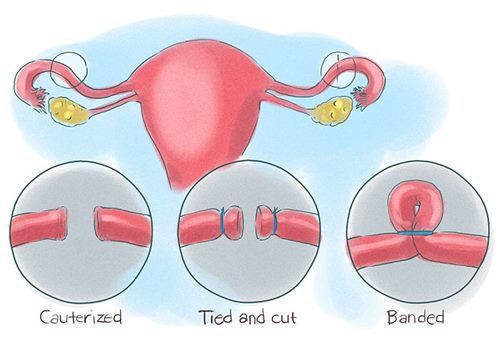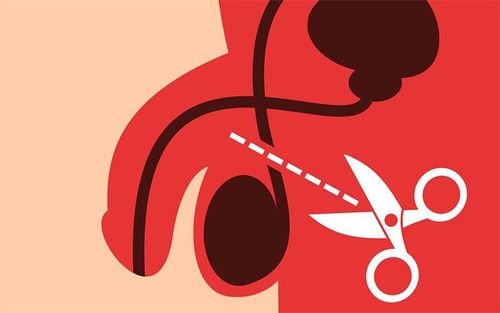This is an automatically translated article.
The article was professionally consulted by Specialist Doctor II Bui Thi Thu and Specialist Doctor II Tran Thi Mai Huong - Department of Obstetrics and Gynecology - Vinmec Hai Phong International General Hospital.1.What is female sterilization by ligation and tubal ligation?
Female sterilization by ligation and tubal ligation is a surgical procedure that interrupts the fallopian tubes, preventing sperm from reaching an ovum for fertilization. This is a permanent contraceptive, very effective in preventing pregnancy (>99%) and does not affect health and sex. However, it should be noted that female sterilization does not prevent sexually transmitted infections and HIV/AIDS.Trắc nghiệm: Bạn có hiểu đúng về dấu hiệu mang thai sớm?
Các dấu hiệu mang thai sớm không phải chỉ mỗi trễ kinh mà còn có rất nhiều dấu hiệu khác như xuất huyết âm đạo, ngực căng tức,… Điểm xem bạn biết được bao nhiêu dấu hiệu mang thai sớm thông qua bài trắc nghiệm này nhé!
2. Advantages and disadvantages of female sterilization by ligation and tubal ligation
2.1 Advantages Female sterilization by ligation and tubal ligation has the following advantages:
High contraceptive effectiveness, one-time surgery has a permanent contraceptive effect. After surgery, it is safe to have an immediate contraceptive effect and has no side effects. In essence, the process of ovulation still takes place, does not affect menstruation. Does not affect gender, personality, health and sexual activity.

2.2 Disadvantages The disadvantages of female sterilization by ligation and tubal ligation are:
Hospitalization and surgery. There should be a medical facility with qualified equipment and a team of doctors with expertise in female sterilization during surgery. Expensive surgery. Difficulty restoring fertility. Complications are likely to occur if the surgical procedure is not followed closely.
3. Indications and contraindications for female sterilization
3.1 Indications You can perform female sterilization by ligation and tubal ligation if you belong to the following groups:
Women of childbearing age have had enough desired children, healthy children , voluntarily adopt a permanent and irreversible method of contraception after adequate counseling. Women with diseases contraindicated to pregnancy.

3.2 Contraindications Female sterilization is not for everyone. This measure has no absolute contraindications, but before performing female sterilization, it is necessary to consider and be cautious and postpone it in special cases:
Cases requiring caution (can be performed normally) with special preparation) if the woman has one of the following characteristics:
Obstetrical disease (previous or current) such as: history of pelvic inflammatory disease from previous pregnancy, uterine fibroids, cancer breast, pelvic or lower abdominal surgery. Cardiovascular disease such as: hypertension (140/90-159/99 mmHg), history of stroke or uncomplicated heart disease. Chronic diseases such as: epilepsy, uncomplicated diabetes, compensated cirrhosis, liver tumor or liver schistomomiasis, hypothyroidism, moderate iron deficiency anemia (hemoglobin 7-0g/Dl), polycythemia vera sickle, thalassemia, kidney disease, diaphragmatic hernia, severe malnutrition, obesity, depression or being young. Cases are postponed if the client has one of the following characteristics:
Pregnant or during 7 - 42 postpartum days. Postpartum pregnancy with preeclampsia or eclampsia. Postpartum complications, after curettage, such as: infection, bleeding, trauma or blood stasis in the uterus, abnormal vaginal bleeding suggest a medical disease. Pelvic or pyelonephritis, Chlamydia or gonococcal cervicitis. Pelvic cancer or malignancy. Symptomatic gallbladder disease or acute viral hepatitis. Severe iron deficiency anemia (hemoglobin < 7 g/Dl). Lung diseases such as pneumonia, bronchitis. Systemic infection or abdominal skin infection. Persons preparing for surgery due to emergency or infection. Cases requiring special preparation (experienced surgeons or facilities for endotracheal anesthesia or necessary resuscitation facilities), if the client has one of the following characteristics:
Has AIDS or The uterus is fixed due to previous surgery, infection or diagnosis of endometriosis, umbilical or abdominal wall hernia or rupture, uterine perforation after childbirth, after abortion. Many conditions can increase the risk of stroke such as older age or heavy smoking, high blood pressure, diabetes or existing severe hypertension (>= 160/100 mmHg) or diabetes with complications. . Medical conditions such as: decompensated cirrhosis, hyperthyroidism, coagulopathy, chronic lung disease or pelvic tuberculosis.
4. Is female sterilization surgery painful?
Before performing tubal ligation and tubal ligation surgery, the client needs to be anesthetized to relieve prolonged pain after surgery. Analgesia is carried out with analgesia and sedation injected intravenously 30-60 minutes before surgery, or 5mg orally if the client is too worried. You will remain awake but feel drowsy and feel only slight discomfort during surgery. Depending on health conditions, equipment and experience, one of the following three techniques can be applied:
Local anesthetic with 1% lidocaine. The maximum dose should not exceed 4.5 mg/kg body weight (maximum dose for 50 kg women is 25ml 1% lidocaine). Indications for endotracheal anesthesia for those who cannot perform local anesthetic procedures (usually applied to obesity, old incisions, psychiatric patients). Epidural anesthesia is rarely used. The following two methods are only used in hospitals.

5. Time to conduct
Female sterilization can be performed at any time during the menstrual cycle when it is certain:
Not pregnant. After normal delivery: The best time is within the first 7 days or delay to the time after 6 weeks postpartum. After abortion: Within the first 7 days (if the uterus is clean, no infection). Combined sterilization after lower abdominal surgery for other reasons (cesarean section, ovarian cyst surgery ...) and customer's request. Before deciding to perform female sterilization by ligation and tubal ligation, the client should be thoroughly consulted and signed a voluntary sterilization application.
6. Follow-up and care after sterilization
Subjects undergoing female sterilization must be monitored for their general condition, pulse, blood pressure, and breathing rate in the first 6 hours after the procedure and can go home after their condition stabilizes (usually within a day). Signs that the client is stable are:
The client stands with his eyes closed and arms extended straight out in front of him (Romberg sign). Customers are awake and able to dress themselves. Use antibiotics if there is a risk of infection. Care of the incision immediately after sterilization:
Keep the incision dry and clean. You can shower after 24 hours, take a gentle bath to avoid wetting the incision. Avoid touching the incision Suture the incision on the 6th day at the commune health station (if sutures are not absorbed). Avoid heavy work and avoid sexual activity for 1 week.

7. Feeling after surgery
After female sterilization with ligation and tubal ligation , you may feel tired, mild abdominal pain or shoulder pain. There may also be feelings of dizziness, nausea, and bloating. Most of these symptoms only last for a few days. Contact a doctor or directly to a medical facility immediately if you have the following symptoms:
Fever. Abdominal pain does not decrease or increase. Bleeding, pus in the incision. Swelling of the surgical site. Missed period, suspected pregnancy.
8. Accidents and complications
Female sterilization by ligation and tubal ligation is prone to complications if the surgical procedure is not followed closely. Possible complications are:
Bleeding in the abdomen. Pelvic infection, peritonitis. Formation of a hematoma. Bleeding and infection of the surgical site. Some rare conditions: damage to the uterus, intestines, bladder. In case of failure after sterilization, there may be an ectopic pregnancy. It should be emphasized that female sterilization does not protect you against STIs, so you should use condoms.
Please dial HOTLINE for more information or register for an appointment HERE. Download MyVinmec app to make appointments faster and to manage your bookings easily.














